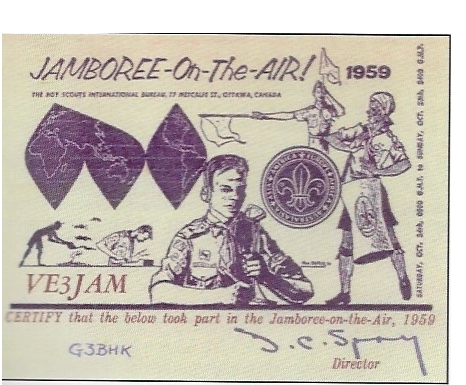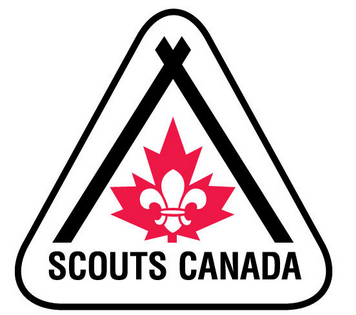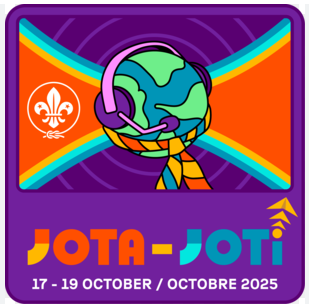On October 18-19, 2025, Ottawa Amateur Radio operators provided radio-communications support for Jamboree on the Air (JOTA) – Jamboree on the Internet (JOTI) 2025 at Scouts Headquarters and online.
JOTA-JOTI is the world’s largest radio and Internet Scouting event. JOTA uses Amateur Radio and JOTI uses Internet Relay Chat (IRC) to connect Scouts around the world, across Canada, and in their own communities. Scouts also share their experiences on the Web (e.g., Facebook, Teams, Google Meets) using @jota_joti and #JOTAJOTI.
The first Scout Ham station was set up in the UK in 1911 and Scouts were keen to communicate!
Ottawa Amateurs have long played pivotal roles in JOTA-JOTI. The very first JOTA in 1958 was organised right here in Ottawa on behalf of Scouting’s World Bureau by Ray Thornton, VE3RT. Conditions were poor that year and yielded only 5 QSO’s (contacts), but Radio Scouting was considered an important program. JOTA 1959 was organised by Ottawa Amateur operator Len Jarrett, who secured call sign VE3JAM, and JOTA has been a permanent feature on the third full weekend of October ever since.

This year, Ottawa’s event at Scouts Canada’s former National Office saw another jump in attendance with 84 participants, an increase of nearly 45% over last year, including two Scouts troops, one Cub pack, and many drop-ins.
Connecting over high frequency (HF) radios to far away stations is the main event (and challenge) at JOTA, but there are also many other activities and displays aimed at stimulating interest in communicating and radio science.
This year, JOTA-JOTI activities included:
- Making QSO’s (contacts) with Scouts and other people from around the world using:
- Long-range high frequency (HF) radios (3-30 MHz) using voice. Thanks to Stephen, VA3ISE, and his filters and radios, we had the ability work on five HF bands at the same time. The bands were open to Europe, so we made a lot of contacts there: England, Spain, Sweden, etc.
- Short-range very high frequency (VHF) radios (30-300 MHz) that bounced signals off of a radio repeater.
- Short-range ultra-high frequency (UHF) radios (300 MHz-3 GHz) and line-of-sight propagation.
- Digital modes of communication
- Learning about Morse Code from CW (Continuous Wave) operators
- Participating in a radio fox hunt by using directional antennas to find hidden VHF transmitters (Foxes) in the surrounding area.
- Participating in hands-on games and activities over family radio service (FRS) radios (walkie-talkies) to explore the importance of communicating clear instructions that can’t be misinterpreted. Games and activities included:
- The classic game Battleship, where players alternate calling “shots” on battleships marked on ruled grids or a plastic board.
- Building a LEGO® structure, with an “instructor” team providing step-by-step instructions to a “builder” team that attempts to assemble it.
- Origami over the air, with an “instructor” team providing step-by-step instructions to a “paper folding” team that attempts to assemble an origami structure, such an elephant or a fox.
- Knots over the air, with an “instructor” team providing step-by-step instructions to a “knot tying” team that attempts to tie essential knots like the square knot, the bowline and more.
- Taking part in a treasure hunt by section: Beavers, Cubs, Scouts, Venturers, Rovers, or Leaders.
- Participating in a simulated community support radio network, in which Scouts decipher voice and CW (Morse code) messages transmitted by an Amateur Radio operator or Scout Leader.
- Getting sign-off on three badge requirements of the Scouts Outdoor Adventure Skills (OAS) program that need knowledge of Weatheradio”WX” radio at the display about this network of radio transmitters. The WX radio network stretches from the Gulf of Mexico into Canada’s Arctic and from Newfoundland to Vancouver Island. The transmitters operate 24/7 on specific VHF frequencies (162.400-162.550 MHz), providing continuous broadcasts of weather information and instant updates in both official languages when weather threatens. Scouts could visit the WX radio display and get their badge requirements signed off.
There were also displays providing information on the following Amateur-Radio topics:
- Q-codes: Standardized three-letter codes, all starting with “Q,” that are used in Amatuer Radio communication to convey information more quickly and accurately, especially with Morse code.
- The ICAO (International Civil Aviation Organization) Phonetic Alphabet: The international standard for voice communication that uses unique, easy-to-understand words for each letter of the English alphabet to prevent misunderstandings. It is used in aviation, military, and Amateur Radio, and other fields.
- Hamclock: HamClock is a kiosk-style application that provides real time space weather, radio propagation models, operating events and other information particularly useful to the radio amateur.
- Radio spectrum: Part of the electromagnetic spectrum with frequencies from 3 KHz to 3,000 GHz that is widely used in modern technology, particularly in telecommunication. Generation and transmission of radio waves is strictly regulated by national laws, coordinated by the International Telecommunication Union (ITU).
- Weak signal propagation reporter (WSPR) (pronounced “whisper”): a protocol, implemented in a computer program, used for weak-signal radio communication between Amateur Radio operators and includes sending and receiving low-power transmissions to test propagation paths on the medium frequency (MF) and HF bands.
- Automatic packet reporting system (APRS): an Amateur Radio-based system for real time digital communications of information of immediate value in the local area, including object Global Positioning System (GPS) coordinates, non-directional beacon, weather-station telemetry, text messages, announcements, queries, and other telemetry.
- Citizens band radio (CB radio): A land mobile radio system allowing short-distance one-to-many bidirectional voice communication among individuals, using two-way radios operating near 27 MHz (or the 11-m wavelength) in the high frequency or shortwave band. Citizens band is distinct from other personal radio service, including Amateur Radio (“ham” radio).
- Marine VHF radio: a worldwide system of two-way radio transceivers on ships and watercraft used for bidirectional voice communication from ship-to-ship, ship-to-shore (for example with harbormasters), and in certain circumstances ship-to-aircraft. It uses FM channels in the VHF maritime mobile band (between 156 and 174 MHz), designated by the International Telecommunication Union (ITU).
JOTA-JOTI events offer Scouts the opportunity to communicate with others on a world-wide scale. Can you imagine a better way to get the feeling of belonging to a really big movement and to contribute to mutual understanding and respect?
Learn more on the global JOTA-JOTI webpage and Scouts Canada JOTA-JOTI webpage.



Last Updated on 2025-11-06 by Joannadanna